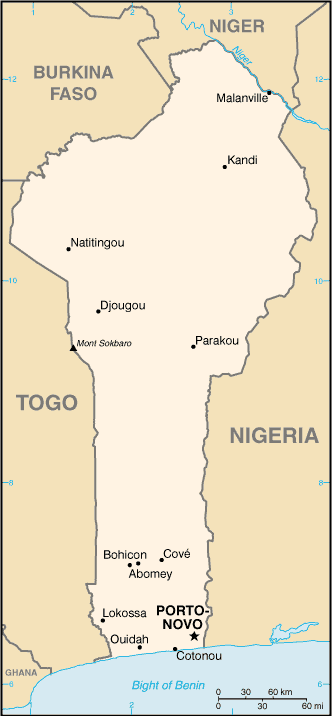| Benin |
|
|
 |
|
| Geography | |
| Location: | Western Africa, bordering the Bight of Benin, between Nigeria and Togo. |
| Area: | total:
114,763
sq km land: 110,622 sq km water: 2,000 sq km |
| Natural Resources: | Small offshore oil deposits, limestone, marble, timber |
| Population and Health | |
| Population: | 10,160,556 (July 2014 est.) |
| Age structure: | 0-14 years: 43.8% (male 2,269,896/female 2,179,026) |
| Population growth rate: | 2.81% (2014 est.) |
| Birth rate: | 36.51 births/1,000 population (2014 est.) |
| Death rate: | 8.39 deaths/1,000 population (2014 est.) |
| Sex ratio: | at birth: 1.05 male(s)/female |
| Infant mortality rate: | total: 57.09 deaths/1,000 live births |
| Life expectancy at birth: | total population: 61.07 years |
| Total fertility rate: | 5.04 children born/woman (2014 est.) |
| Current contraceptive use among married women 15-49 years old(any method) | 13% (2007-2012) |
| Unmet need of contraceptive | 27.3% (2006) |
| HIV/AIDS - adult prevalence rate: | 1.1% (2012) |
| HIV/AIDS - people living with HIV/AIDS: | 71,500 (2012) |
| HIV/AIDS - deaths: | 3,100 (2012) |
| Literacy: | definition: age 15 and over can read and write |
| Economy | |
| GDP (purchasing power parity): | $16.65 billion (2013 est.) |
| GDP (official exchange rate): | $8.359 billion (2013 est.) |
| GDP - real growth rate: | 5% (2013 est.) |
| GDP - per capita (PPP): | $1,600 (2013 est.) |
| GDP - composition by sector: | agriculture: 31.6% |
| Labor force - by occupation: | 3.662 million (2007 est.) |
| Population below poverty line: | 37.4% (2007 est.) |
| Inflation rate (consumer prices): | 2.4% (2013 est.) |
| Agriculture - products: | cotton, corn, cassava (tapioca), yams, beans, palm oil, peanuts, cashews; livestock |
| Industries: | textiles, food processing, construction materials, cement |
| Industrial production growth rate: | 3.7% (2013 est.) |
| Exports - commodities: | cotton, cashews, shea butter, textiles, palm products, seafood |
| Currency (code): | Communaute Financiere Africaine franc (XOF); note - responsible authority is the Central Bank of the West African States |
| Fiscal year: | Calendar year |
| Others | |
| Nationality: | noun: Beninese
(singular and plural) adjective: Beninese |
| Religions: |
Christian 42.8% (Catholic 27.1%, Celestial 5%, Methodist 3.2%, other Protestant 2.2%, other 5.3%), Muslim 24.4%, Vodoun 17.3%, other 15.5% (2002 census) |
| Languages: |
French (official), Fon and Yoruba (most common vernaculars in south), tribal languages (at least six major ones in north) |
| Country name: | conventional
long form: Republic of Benin conventional short form: Benin former: Dahomey |
| Government type: | Republic |
| Capital: | name: Porto-Novo
(official capital) geographic coordinates: 6 29 N, 2 37 E time difference: UTC+1 (6 hours ahead of Washington, DC during Standard Time) |
| Administrative divisions: | 12 departments; Alibori, Atakora, Atlantique, Borgou, Collines, Kouffo, Donga, Littoral, Mono, Oueme, Plateau, Zou |
| Independence: | 1 August 1960 (from France) |
| Legal system: | based on French civil law and customary law; has not accepted compulsory ICJ jurisdiction |
|
|
Source : UN_Demographic and Health Surveys (DHS), Multiple Indicator Cluster Surveys (MICS) and other national surveys; United Nations Population Division Update date: August 2014 |
|